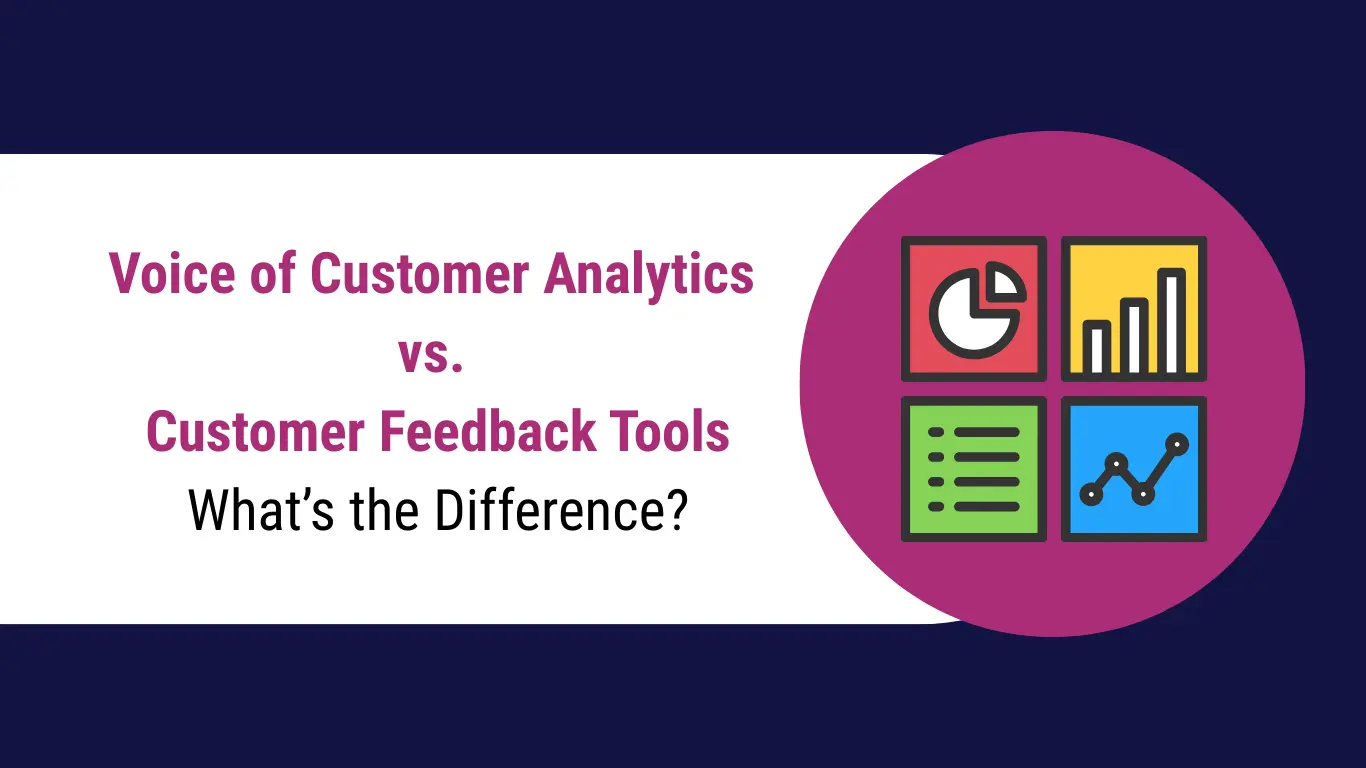You ask your customers how you’re doing, and the feedback looks positive.
It’s common to see organizations highlight their survey data, feedback forms, and NPS scores as proof points. On paper, their customers look satisfied. But a month later, churn spikes or sales dip unexpectedly.
That’s precisely where many businesses get stuck. They collect feedback, but they don’t always understand the deeper story behind it. And this is where the real difference between customer feedback tools and Voice of Customer sentiment analysis (VoC) comes into play.
Let’s have a look exactly, I’m trying to tell you…
What Are Customer Feedback Tools?
Customer feedback tools are like the comment box in a store, digitally upgraded.
Think of surveys, star ratings, review forms, or post-purchase questionnaires. These tools are essential because they capture direct customer opinions in their own words.
They tell you what customers are saying.
But…
… they rarely tell you why they feel that way.
For example, a customer might rate your service as 3 out of 5. Useful? Yes. However, does that number indicate whether they were dissatisfied with pricing, support wait times, or product usability? Not really.
That’s the limitation of relying only on feedback tools.
What Is the Voice of Customer Sentiment Analytics?
Now, let's view things from the other side. Voice of customer sentiment analysis goes beyond star ratings and survey forms. It doesn’t just look at what customers said, it digs into how they said it, what emotions they expressed, and what patterns emerge across thousands of conversations.
Using sentiment analysis tools, businesses can detect if customers are expressing excitement, frustration, confusion, or delight, even when the words aren’t obvious.
In short, feedback tools collect opinions. VoC analytics interprets emotions and turns them into action.
Why the Confusion Between the Two?
It’s easy to see why businesses blur the line between personal and professional. Both involve listening to customers. Both involve data. But here’s the difference:
Think of feedback tools as the thermometer, and voice of customer sentiment analysis as the whole health check-up. One shows the temperature; the other explains the condition.
The Real Value of Voice of Customer Sentiment Analysis
So why are more businesses shifting from just feedback to VoC sentiment analysis?
Because today’s customers don’t just want you to listen; they want you to understand and act.
Here’s what you get with it -
Identify Pain Points Faster
Customers may not always complain directly. But when you analyze their tone across channels, you’ll see patterns that feedback scores miss.
Predict Churn Before It Happens
Subtle negative emotions in chat logs or social comments often signal frustration long before a customer cancels.
Boost Product Innovation
By analyzing the language customers use when describing your product, you uncover unmet needs and feature gaps.
Prioritize Business Decisions
Instead of guessing where to allocate budget, you let customer sentiment guide you, whether that’s improving support, tweaking UX, or rethinking pricing.
And feedback tools will tell you “customers aren’t happy.” But VoC analytics tells you why, how big the issue is, and what you should do next.
Voice of Customer Tools - The Engine Behind the Insights
To make this possible, you need the right Voice of Customer tools. These platforms integrate surveys, review monitoring, call analytics, and AI-powered dashboards into a single ecosystem.
Instead of switching between multiple spreadsheets and apps, you see a consolidated view of customer voices, scored, segmented, and ready for action.
Some tools even let you integrate with CRM systems, meaning sales, marketing, and service teams all see the same customer sentiment data in real time.
Voice of the Customer Best Practices
Okay, so you’re convinced that sentiment analysis beats plain feedback. But how do you make it work in practice? Here are some voice of the customer best practices that top brands follow:
Mix Direct and Indirect Feedback
Don’t just rely on surveys. Pull insights from social media, chats, and reviews too.
Automate With Sentiment Analysis Tools
AI can process thousands of customer interactions in minutes, something manual teams could never do.
Close the Loop
It’s not enough to listen; you need to respond. If customers see you act on their input, loyalty skyrockets.
Share Insights Across Teams
When marketing, product, and service teams align on what customers feel (not just what they say), you get faster fixes, better messaging, and proactive support.
Track Over Time
Measure monthly or quarterly to spot trends, tie them to actions, and see if changes are truly paying off.
Following these practices ensures you don’t just collect data, you actually turn it into better decisions.
Sentiment Analysis Tools – An Evolution
Without the right tech, analyzing customer voices at scale is impossible. That’s why modern sentiment analysis tools are critical.
These tools use natural language processing (NLP) to detect context, tone, and intent. For instance, a customer saying “The product is sick” could be flagged as negative in basic feedback software, but NLP can recognize slang and classify it as positive.
That nuance is what separates guesswork from accurate insights.
Where Customer Feedback Tools Still Matter?
Now, let’s be fair, customer feedback tools aren’t obsolete. They’re still valuable because –
- They provide you with structured, easy-to-understand data (such as NPS scores).
- They’re the quickest way to ask targeted questions.
- They provide benchmarks over time.
But remember, they’re a piece of the puzzle, not the whole picture. Relying only on feedback is like trying to complete a jigsaw with half the pieces missing.
So,
Customer Feedback Tools → Collect structured opinions.
Voice of Customer Analytics → Interprets emotions, context, and hidden patterns.
Businesses that combine both don’t just hear their customers; they truly understand them.
So next time you look at a dashboard full of survey scores, ask yourself –
Am I just reading numbers, or am I understanding voices?
Because the brands that win in this AI era won’t just be the ones who listen; they’ll be the ones who decode the unspoken emotions behind every customer interaction.
Voice of customer sentiment analysis is no longer a “nice to have”; it’s a business necessity. With the right customer voice tools, following best practices for the voice of the customer, and leveraging modern sentiment analysis tools, you can move your business strategy from reactive problem-solving to proactive growth.
At Express Analytics, we believe that every business already has the answers it’s looking for, hidden in the voices of its customers.
The question is: Are you ready to listen, decode, and act?


